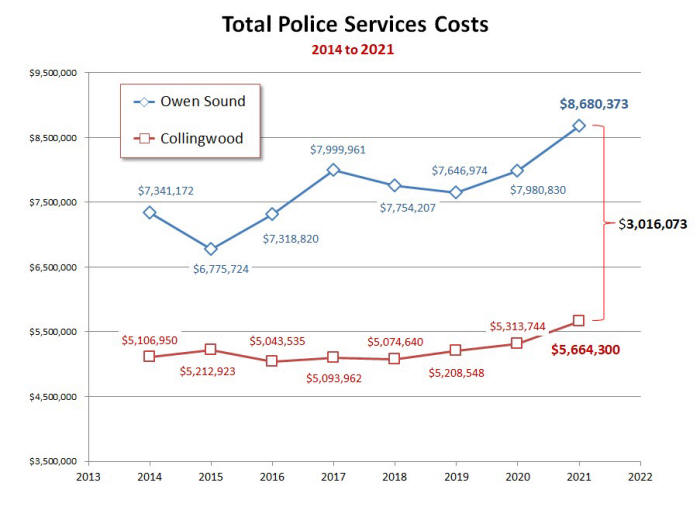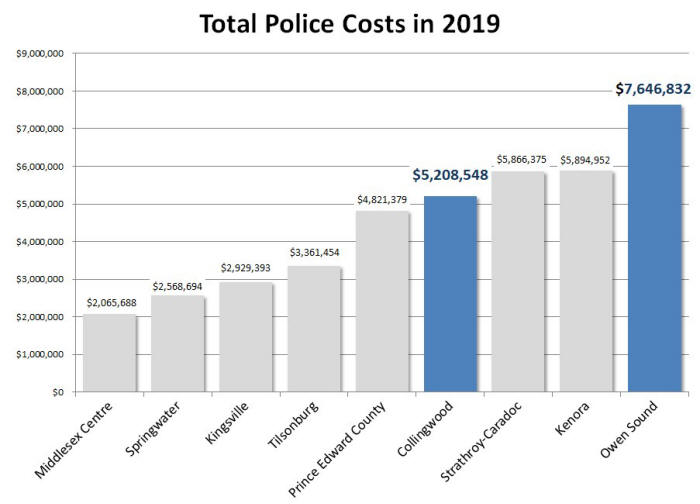 |
| Figure 9; Protective Services Comparison source: BMA Municipal Studies |
Comparing Owen Sound and Collingwood – Part III
 |
| Figure 9; Protective Services Comparison source: BMA Municipal Studies |
The above graph shows the cost of Fire and Police services for both
municipalities in the year 2018. Again, the BMA studies display the data for
most of their studies relative to $100,000 of assessment. So, the difference in
the cost per $100,000 of assessment doesn’t really tell us much since each municipality has a
different assessment. However, what’s significant about the graph above is that
the cost for Fire Services is nearly identical for each municipality while the
cost for Police Services is vastly difference. Therefore it’s reasonable to
conclude that it is not Fire Services that is driving up the costs. So we
need to do a comparison of Police Services for both municipalities to get a
better understanding of what’s driving costs.
To achieve this we have to look at the actual cost for each year. Fortunately,
the Town of Collingwood has structured their Audited Financial Statements so
that the individual statements for each department are included. Therefore it
was a simple process to record the total annual expenses for Police services for
Collingwood. Unfortunately, Owen Sound Audited Financial Statements do not give
taxpayers the same visibility into the individual department statements. Several
departments are included in each statement identified in the Audited Financials.
For example, the Protective Services statement includes the police board, police
department operations and fire department operations. However we can calculate
Police Services expenses by using the per capita assessment data provided in the BMA reports along with the census data from Statistics Canada.
The BMA Reports provide us with the cost of Police Services on a basis of cost
per $100,000 of assessment. Since Collingwood and Owen Sound have different
Assessments we need to calculate the total cost of Owen Sound’s Police Services.
The BMA Reports provide us with the assessment on a per capita basis. We first
find the total assessment by multiplying the BMA numbers by the population for
each year. To obtain an estimate of population for the years between each census
year we assume a linear change in population between the years and calculate an
estimate for the population.
We then calculate the cost for Police Services for Owen Sound by dividing the total assessment by 100,000 and multiply this by the BMA report data for police services. We obtained the total cost of police services for Collingwood directly from their audited financials. The result is displayed in the graph below.
 |
| Figure 10; Police Services Comparison source: BMA Municipal Studies and Collingwood Financials |
We can easily see from the graph about that unlike Fire Services the cost of
Police services is far from being relatively equal. In 2021 Owen Sound spent
about $3 million or 53.2% more on Police Services than Collingwood spent on
their Police services. Note, for Owen Sound BMA gives us the net costs so these
figures are reduced by grants and other revenues which are in the order of $2
million per year.
Collingwood contracts it police services from the Ontario Provincial Police. The
cost for this contract was $5,476,405 in 2021. In 2017 Owen Sound received a
proposal from the Ontario Provincial Police to provide Owen Sound with police
services at an annual cost of $8,485,056 after initial start-up costs. (Click
Here to Review) As you can see the OPP costing did not include revenue
from grants and other income which seem to be in the order of $2 million. The
total cost for Police Services in 2019 and 2020 before applying grants was
$10,417,159 and $10,857,671 respectively as shown in the budgets on the Owen
Sound Website
(Click Here). As well you can also see this data in the Financial
Notes to the city’s Audited Financial Statements.
Given that Owen Sound’s Policing Costs are in the order of $3 million greater
than Collingwood’s costs and that current policing costs are in the order of $2
million greater than the OPP 2017 proposal it would seem appropriate for Council to revisit
the OPP proposal.
 |
| Figure 11; Police Services Cost Comparison source: BMA Studies and Collingwood's Financials |
When we compare the net cost of police services for similarly sized
municipalities we see that Owen Sound pays significantly more for police
services than all similarly sized municipalities. Note, these represent the net
costs after grants and other revenues are included. This confirms that the
comparison with Collingwood was not unique and that Owen Sound is definitely
over paying for police services. Unless Owen Sound’s crime rate is
much higher than the municipalities we used for the comparison, it is highly likely that
the Owen Sound police department is overstaffed as compared to Collingwood's.
Comparing the Highest Salaries
One of the largest cost drivers for most public sector institutions is the cost
of Salaries and Benefits. To have a good understanding of salary costs we need
to look at the size of the workforce in addition to salary costs. Unfortunately
Owen Sound stopped reporting workforce sizes in 2016. However we can get a good
feeling for the salary differences between the two municipalities by reviewing
those salaries over $100,000 as reported online at
www.ontariosunshinelist.com.
 |
| Figure 12; Cost of Salaries of Employees on the Sunshine List source: Owen Sound and Collingwood |
As shown above, we see evidence that Owen Sound is either overstaffed at the
senior levels or paying senior staff salaries in excess of the norm. For example,
Owen Sound had 73 employees in 2021 receiving salaries greater than $100,000 for
a total cost of $8,982,610. Collingwood, on the other hand, had only 47
employees receiving salaries greater than $100,000 for a total cost of
$5,811,265. That works out to be a difference of $3,171,345. This is
remarkable given that Collingwood has a larger population and a higher
assessment than Owen Sound.
Even more interesting is that 36 of the 73 employees with salaries greater than
$100,000, were in the Police Department, this included 22 Constables, 5
Sergeants and 4 inspectors. That’s almost half of the total number of employees
with salaries greater than $100,000. This strongly suggests that Council needs
to take a very serious look at the cost of Police Services.
It is clear that expenses grew at a rate that was disproportionate to
population growth and are now much greater than similarly sized municipalities.
It would appear that a contributing factor was the growth in staff numbers and
salaries. Reducing staffing levels can be difficult. I faced this challenge in
my last position where I employed a number of techniques aimed at getting
“buy-in” from staff on the need to “Right-Size” the organization, that I would
be happy to share with Council when and if there is ever an appetite for change.
Conclusions
So, what did we learn from doing this comparison with Collingwood? We all knew
before the comparison that Owen Sound hasn’t been growing for some time. So, it
wasn’t a surprise that Owen Sound’s population and assessment was pretty
much stagnant during the study period. It also wasn’t a surprise that Owen
Sound’s taxes were much higher than Collingwood’s in spite of fact that
Collingwood has a larger population. However, we did learn a few things about
the depth of the impact our financial problems and about some of the driving
forces behind the annual taxes that were consistently increased each year at a
rate that was twice the rate of inflation. Below is a brief summary.
In summary it is clear to me that Owen Sound has expenses that, at a
minimum, are at least $4 million more than they really need to be. This is
the difficult topic that Council will have to face head-on. It cannot be
avoided if we are to make any progress in even slowing the downhill slide
we’ve been on for the last 20 years. We do not need a staff study or a
committee report. Everyone knows what needs to happen.
Council needs to have a closed door session with the City Manager and direct
him to develop a plan that matches Collingwood’s staffing levels within 24
months and at the same time maintains current service levels. This will
require a $4 million reduction in Salary and Benefits to meet Collingwood’s
current level of $22 million. Although this is a significant staffing
reduction it is very achievable. However, it will come with some short term
financial pain. It will require the introduction of early retirement bonuses
and other incentives to encourage voluntary resignations in addition to
legislated severance. The bottom line is the city has an overabundance of
senior staff in comparison to other similarly sized municipality and Council
owes it to taxpayers to fully address this disparity.
On a positive note, a portion of the $4 million annual savings could be
directed to address our growing social problems. We currently have a very
serious problem in our community where some of our residents are living in
tents and sleeping in the streets. If Council were to begin to practice
sound financial management and reduce expenses by at least $4 million we
could subsidize housing for the 300 to 500 un-housed residents in Owen Sound
by implementing a “Housing First” program.
The feedback I received when offering solutions to candidates, to mitigate
the pain felt by these residents, was that this is a “County Problem”. I
disagree with this position. Although the County is attempting to address
this issue for all municipalities in the County, it is a City of Owen Sound
Problem and I’ve just given you the solution.